Biology 10: Exploring Cystic Fibrosis Association with Plasma Membrane
VerifiedAdded on 2022/08/11
|11
|2730
|42
Project
AI Summary
This research proposal for a Biology 10 course delves into cystic fibrosis (CF), an inherited disease characterized by thick mucus buildup damaging organs. The study investigates CF's association with the plasma membrane, a crucial cell component, and the genetic basis of the disease, specifically focusing on the CFTR protein and its role in chloride ion transport. The methodology employs a systematic literature review to address research questions about the connection between CF and the plasma membrane, and the genetic mutations involved. The expected outcome identifies the structural aspects of the transmembrane regulatory protein, its composition, and its genetic location. The research aims to benefit the understanding of CF and its underlying mechanisms. The study is valuable for further research on the disease. The findings will be disseminated via online journal publication.

Running head: BIOLOGY
CYSTIC FIBROSIS
Name of the Student
Name of the University
Author Note
CYSTIC FIBROSIS
Name of the Student
Name of the University
Author Note
Paraphrase This Document
Need a fresh take? Get an instant paraphrase of this document with our AI Paraphraser
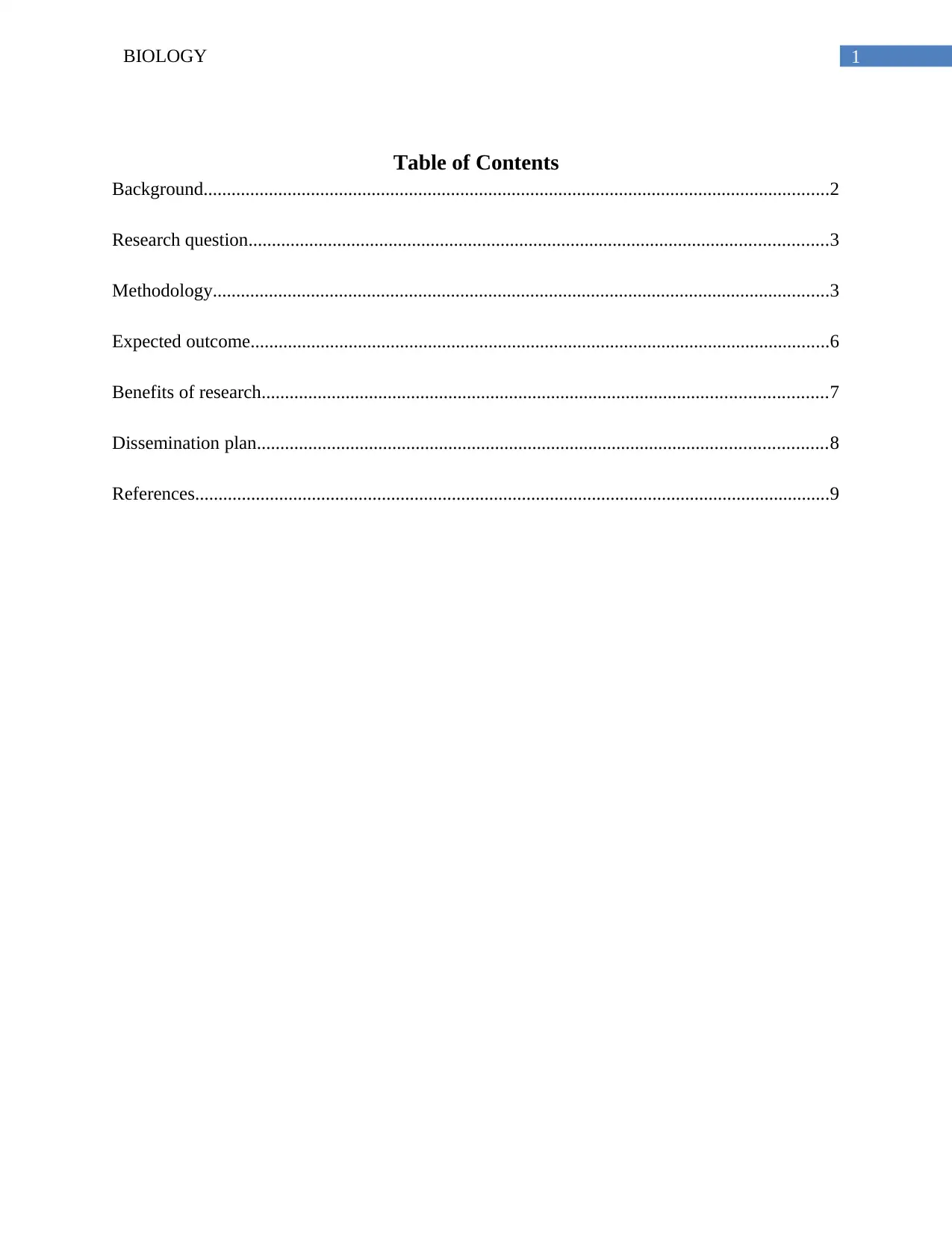
1BIOLOGY
Table of Contents
Background......................................................................................................................................2
Research question............................................................................................................................3
Methodology....................................................................................................................................3
Expected outcome............................................................................................................................6
Benefits of research.........................................................................................................................7
Dissemination plan..........................................................................................................................8
References........................................................................................................................................9
Table of Contents
Background......................................................................................................................................2
Research question............................................................................................................................3
Methodology....................................................................................................................................3
Expected outcome............................................................................................................................6
Benefits of research.........................................................................................................................7
Dissemination plan..........................................................................................................................8
References........................................................................................................................................9
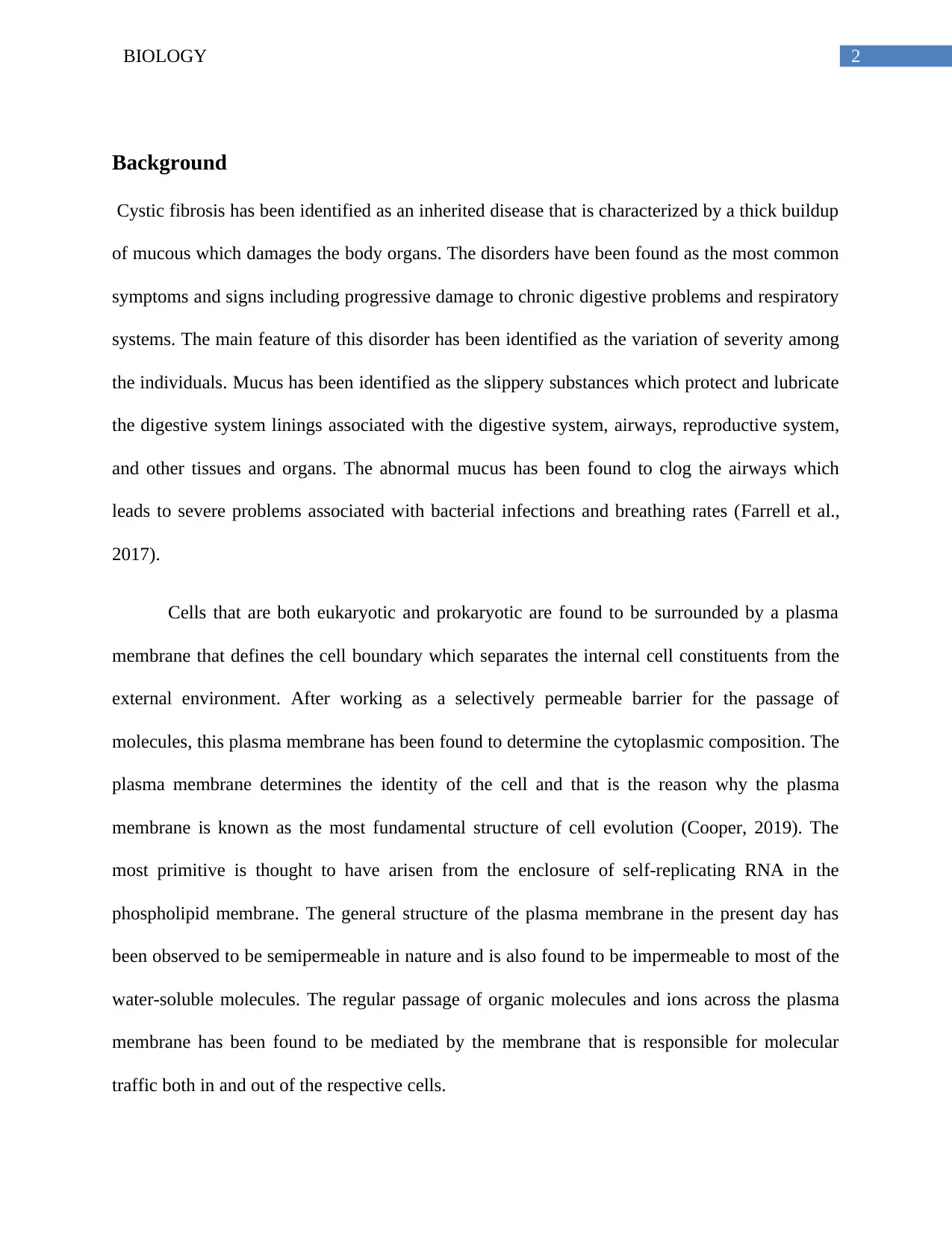
2BIOLOGY
Background
Cystic fibrosis has been identified as an inherited disease that is characterized by a thick buildup
of mucous which damages the body organs. The disorders have been found as the most common
symptoms and signs including progressive damage to chronic digestive problems and respiratory
systems. The main feature of this disorder has been identified as the variation of severity among
the individuals. Mucus has been identified as the slippery substances which protect and lubricate
the digestive system linings associated with the digestive system, airways, reproductive system,
and other tissues and organs. The abnormal mucus has been found to clog the airways which
leads to severe problems associated with bacterial infections and breathing rates (Farrell et al.,
2017).
Cells that are both eukaryotic and prokaryotic are found to be surrounded by a plasma
membrane that defines the cell boundary which separates the internal cell constituents from the
external environment. After working as a selectively permeable barrier for the passage of
molecules, this plasma membrane has been found to determine the cytoplasmic composition. The
plasma membrane determines the identity of the cell and that is the reason why the plasma
membrane is known as the most fundamental structure of cell evolution (Cooper, 2019). The
most primitive is thought to have arisen from the enclosure of self-replicating RNA in the
phospholipid membrane. The general structure of the plasma membrane in the present day has
been observed to be semipermeable in nature and is also found to be impermeable to most of the
water-soluble molecules. The regular passage of organic molecules and ions across the plasma
membrane has been found to be mediated by the membrane that is responsible for molecular
traffic both in and out of the respective cells.
Background
Cystic fibrosis has been identified as an inherited disease that is characterized by a thick buildup
of mucous which damages the body organs. The disorders have been found as the most common
symptoms and signs including progressive damage to chronic digestive problems and respiratory
systems. The main feature of this disorder has been identified as the variation of severity among
the individuals. Mucus has been identified as the slippery substances which protect and lubricate
the digestive system linings associated with the digestive system, airways, reproductive system,
and other tissues and organs. The abnormal mucus has been found to clog the airways which
leads to severe problems associated with bacterial infections and breathing rates (Farrell et al.,
2017).
Cells that are both eukaryotic and prokaryotic are found to be surrounded by a plasma
membrane that defines the cell boundary which separates the internal cell constituents from the
external environment. After working as a selectively permeable barrier for the passage of
molecules, this plasma membrane has been found to determine the cytoplasmic composition. The
plasma membrane determines the identity of the cell and that is the reason why the plasma
membrane is known as the most fundamental structure of cell evolution (Cooper, 2019). The
most primitive is thought to have arisen from the enclosure of self-replicating RNA in the
phospholipid membrane. The general structure of the plasma membrane in the present day has
been observed to be semipermeable in nature and is also found to be impermeable to most of the
water-soluble molecules. The regular passage of organic molecules and ions across the plasma
membrane has been found to be mediated by the membrane that is responsible for molecular
traffic both in and out of the respective cells.
⊘ This is a preview!⊘
Do you want full access?
Subscribe today to unlock all pages.

Trusted by 1+ million students worldwide
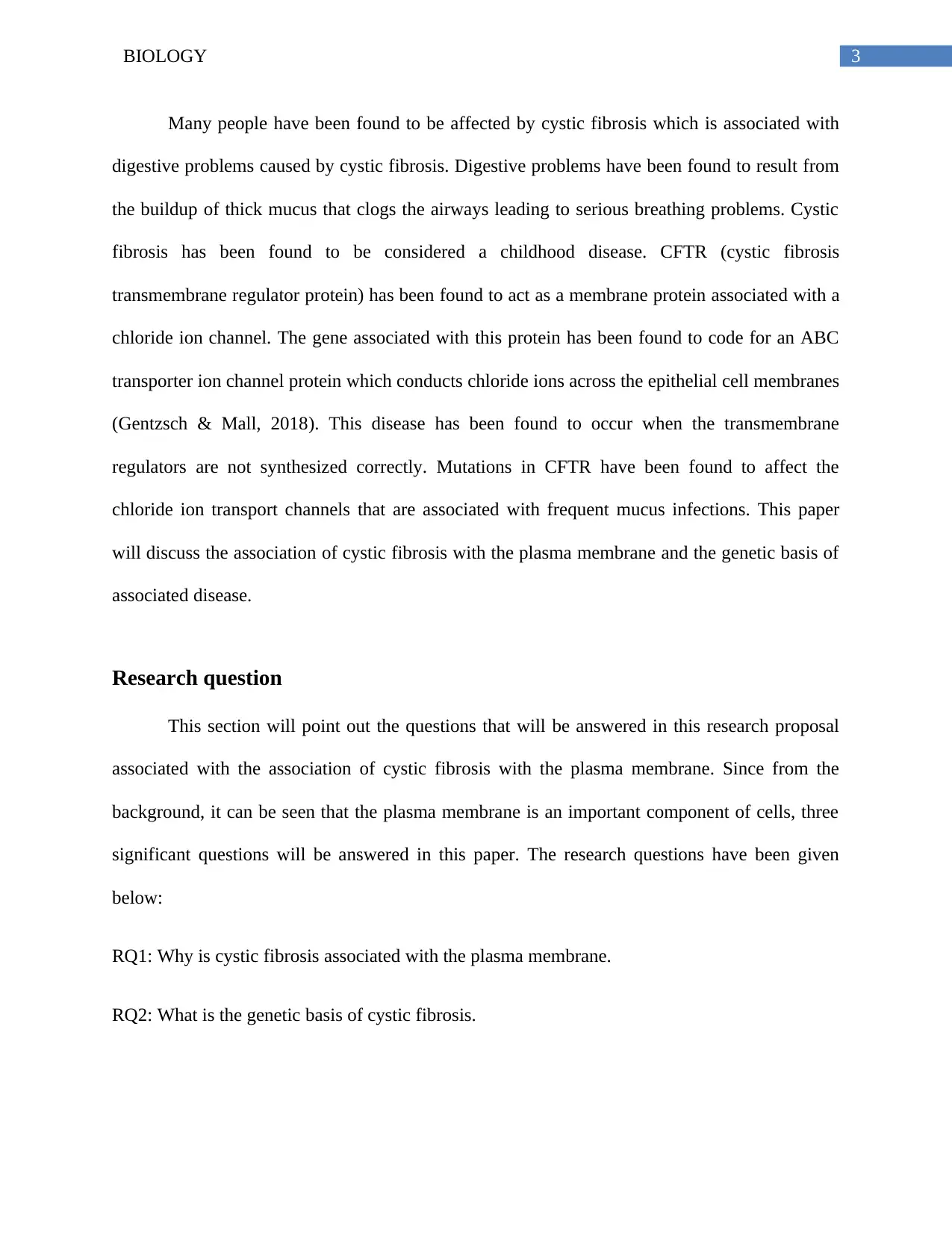
3BIOLOGY
Many people have been found to be affected by cystic fibrosis which is associated with
digestive problems caused by cystic fibrosis. Digestive problems have been found to result from
the buildup of thick mucus that clogs the airways leading to serious breathing problems. Cystic
fibrosis has been found to be considered a childhood disease. CFTR (cystic fibrosis
transmembrane regulator protein) has been found to act as a membrane protein associated with a
chloride ion channel. The gene associated with this protein has been found to code for an ABC
transporter ion channel protein which conducts chloride ions across the epithelial cell membranes
(Gentzsch & Mall, 2018). This disease has been found to occur when the transmembrane
regulators are not synthesized correctly. Mutations in CFTR have been found to affect the
chloride ion transport channels that are associated with frequent mucus infections. This paper
will discuss the association of cystic fibrosis with the plasma membrane and the genetic basis of
associated disease.
Research question
This section will point out the questions that will be answered in this research proposal
associated with the association of cystic fibrosis with the plasma membrane. Since from the
background, it can be seen that the plasma membrane is an important component of cells, three
significant questions will be answered in this paper. The research questions have been given
below:
RQ1: Why is cystic fibrosis associated with the plasma membrane.
RQ2: What is the genetic basis of cystic fibrosis.
Many people have been found to be affected by cystic fibrosis which is associated with
digestive problems caused by cystic fibrosis. Digestive problems have been found to result from
the buildup of thick mucus that clogs the airways leading to serious breathing problems. Cystic
fibrosis has been found to be considered a childhood disease. CFTR (cystic fibrosis
transmembrane regulator protein) has been found to act as a membrane protein associated with a
chloride ion channel. The gene associated with this protein has been found to code for an ABC
transporter ion channel protein which conducts chloride ions across the epithelial cell membranes
(Gentzsch & Mall, 2018). This disease has been found to occur when the transmembrane
regulators are not synthesized correctly. Mutations in CFTR have been found to affect the
chloride ion transport channels that are associated with frequent mucus infections. This paper
will discuss the association of cystic fibrosis with the plasma membrane and the genetic basis of
associated disease.
Research question
This section will point out the questions that will be answered in this research proposal
associated with the association of cystic fibrosis with the plasma membrane. Since from the
background, it can be seen that the plasma membrane is an important component of cells, three
significant questions will be answered in this paper. The research questions have been given
below:
RQ1: Why is cystic fibrosis associated with the plasma membrane.
RQ2: What is the genetic basis of cystic fibrosis.
Paraphrase This Document
Need a fresh take? Get an instant paraphrase of this document with our AI Paraphraser
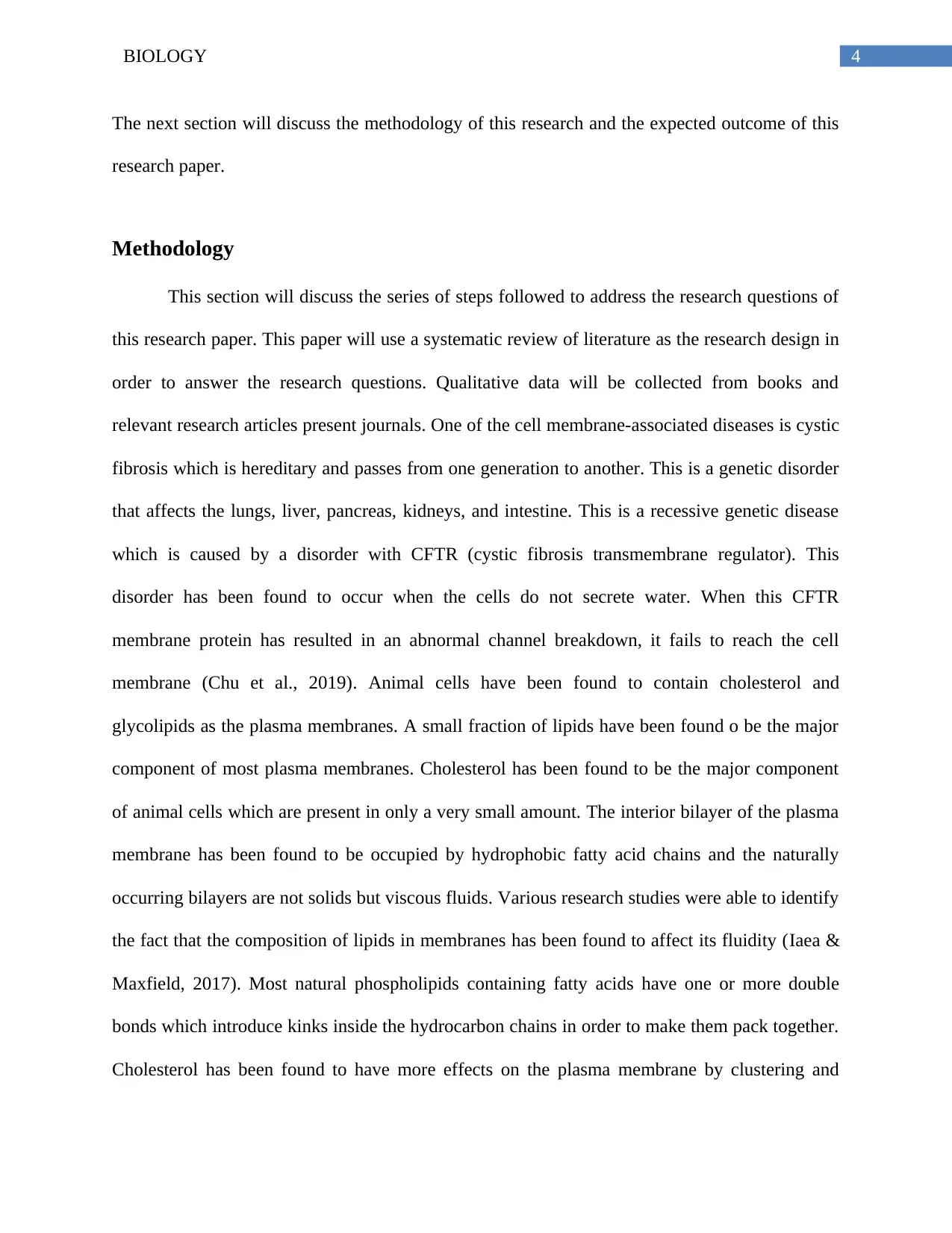
4BIOLOGY
The next section will discuss the methodology of this research and the expected outcome of this
research paper.
Methodology
This section will discuss the series of steps followed to address the research questions of
this research paper. This paper will use a systematic review of literature as the research design in
order to answer the research questions. Qualitative data will be collected from books and
relevant research articles present journals. One of the cell membrane-associated diseases is cystic
fibrosis which is hereditary and passes from one generation to another. This is a genetic disorder
that affects the lungs, liver, pancreas, kidneys, and intestine. This is a recessive genetic disease
which is caused by a disorder with CFTR (cystic fibrosis transmembrane regulator). This
disorder has been found to occur when the cells do not secrete water. When this CFTR
membrane protein has resulted in an abnormal channel breakdown, it fails to reach the cell
membrane (Chu et al., 2019). Animal cells have been found to contain cholesterol and
glycolipids as the plasma membranes. A small fraction of lipids have been found o be the major
component of most plasma membranes. Cholesterol has been found to be the major component
of animal cells which are present in only a very small amount. The interior bilayer of the plasma
membrane has been found to be occupied by hydrophobic fatty acid chains and the naturally
occurring bilayers are not solids but viscous fluids. Various research studies were able to identify
the fact that the composition of lipids in membranes has been found to affect its fluidity (Iaea &
Maxfield, 2017). Most natural phospholipids containing fatty acids have one or more double
bonds which introduce kinks inside the hydrocarbon chains in order to make them pack together.
Cholesterol has been found to have more effects on the plasma membrane by clustering and
The next section will discuss the methodology of this research and the expected outcome of this
research paper.
Methodology
This section will discuss the series of steps followed to address the research questions of
this research paper. This paper will use a systematic review of literature as the research design in
order to answer the research questions. Qualitative data will be collected from books and
relevant research articles present journals. One of the cell membrane-associated diseases is cystic
fibrosis which is hereditary and passes from one generation to another. This is a genetic disorder
that affects the lungs, liver, pancreas, kidneys, and intestine. This is a recessive genetic disease
which is caused by a disorder with CFTR (cystic fibrosis transmembrane regulator). This
disorder has been found to occur when the cells do not secrete water. When this CFTR
membrane protein has resulted in an abnormal channel breakdown, it fails to reach the cell
membrane (Chu et al., 2019). Animal cells have been found to contain cholesterol and
glycolipids as the plasma membranes. A small fraction of lipids have been found o be the major
component of most plasma membranes. Cholesterol has been found to be the major component
of animal cells which are present in only a very small amount. The interior bilayer of the plasma
membrane has been found to be occupied by hydrophobic fatty acid chains and the naturally
occurring bilayers are not solids but viscous fluids. Various research studies were able to identify
the fact that the composition of lipids in membranes has been found to affect its fluidity (Iaea &
Maxfield, 2017). Most natural phospholipids containing fatty acids have one or more double
bonds which introduce kinks inside the hydrocarbon chains in order to make them pack together.
Cholesterol has been found to have more effects on the plasma membrane by clustering and
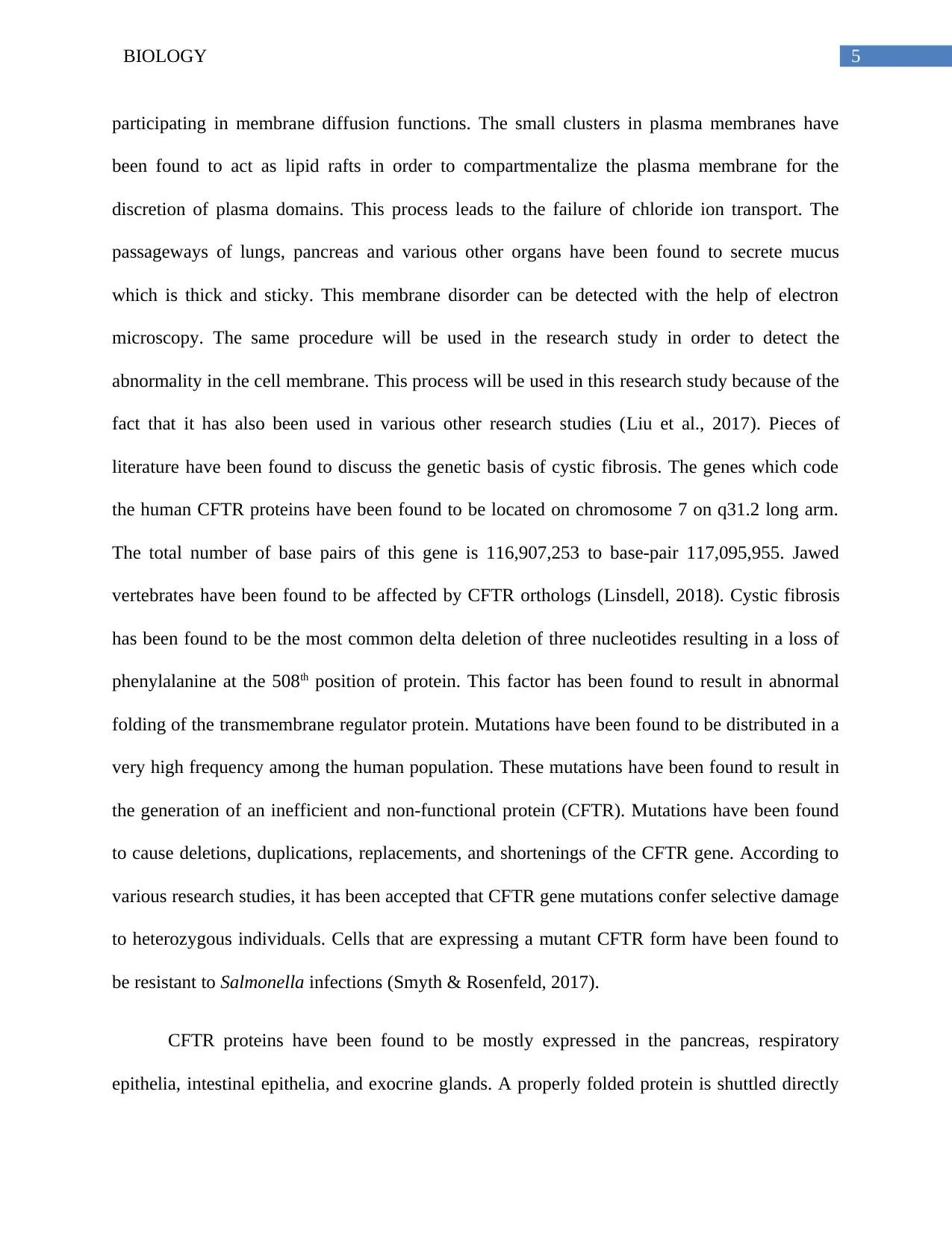
5BIOLOGY
participating in membrane diffusion functions. The small clusters in plasma membranes have
been found to act as lipid rafts in order to compartmentalize the plasma membrane for the
discretion of plasma domains. This process leads to the failure of chloride ion transport. The
passageways of lungs, pancreas and various other organs have been found to secrete mucus
which is thick and sticky. This membrane disorder can be detected with the help of electron
microscopy. The same procedure will be used in the research study in order to detect the
abnormality in the cell membrane. This process will be used in this research study because of the
fact that it has also been used in various other research studies (Liu et al., 2017). Pieces of
literature have been found to discuss the genetic basis of cystic fibrosis. The genes which code
the human CFTR proteins have been found to be located on chromosome 7 on q31.2 long arm.
The total number of base pairs of this gene is 116,907,253 to base-pair 117,095,955. Jawed
vertebrates have been found to be affected by CFTR orthologs (Linsdell, 2018). Cystic fibrosis
has been found to be the most common delta deletion of three nucleotides resulting in a loss of
phenylalanine at the 508th position of protein. This factor has been found to result in abnormal
folding of the transmembrane regulator protein. Mutations have been found to be distributed in a
very high frequency among the human population. These mutations have been found to result in
the generation of an inefficient and non-functional protein (CFTR). Mutations have been found
to cause deletions, duplications, replacements, and shortenings of the CFTR gene. According to
various research studies, it has been accepted that CFTR gene mutations confer selective damage
to heterozygous individuals. Cells that are expressing a mutant CFTR form have been found to
be resistant to Salmonella infections (Smyth & Rosenfeld, 2017).
CFTR proteins have been found to be mostly expressed in the pancreas, respiratory
epithelia, intestinal epithelia, and exocrine glands. A properly folded protein is shuttled directly
participating in membrane diffusion functions. The small clusters in plasma membranes have
been found to act as lipid rafts in order to compartmentalize the plasma membrane for the
discretion of plasma domains. This process leads to the failure of chloride ion transport. The
passageways of lungs, pancreas and various other organs have been found to secrete mucus
which is thick and sticky. This membrane disorder can be detected with the help of electron
microscopy. The same procedure will be used in the research study in order to detect the
abnormality in the cell membrane. This process will be used in this research study because of the
fact that it has also been used in various other research studies (Liu et al., 2017). Pieces of
literature have been found to discuss the genetic basis of cystic fibrosis. The genes which code
the human CFTR proteins have been found to be located on chromosome 7 on q31.2 long arm.
The total number of base pairs of this gene is 116,907,253 to base-pair 117,095,955. Jawed
vertebrates have been found to be affected by CFTR orthologs (Linsdell, 2018). Cystic fibrosis
has been found to be the most common delta deletion of three nucleotides resulting in a loss of
phenylalanine at the 508th position of protein. This factor has been found to result in abnormal
folding of the transmembrane regulator protein. Mutations have been found to be distributed in a
very high frequency among the human population. These mutations have been found to result in
the generation of an inefficient and non-functional protein (CFTR). Mutations have been found
to cause deletions, duplications, replacements, and shortenings of the CFTR gene. According to
various research studies, it has been accepted that CFTR gene mutations confer selective damage
to heterozygous individuals. Cells that are expressing a mutant CFTR form have been found to
be resistant to Salmonella infections (Smyth & Rosenfeld, 2017).
CFTR proteins have been found to be mostly expressed in the pancreas, respiratory
epithelia, intestinal epithelia, and exocrine glands. A properly folded protein is shuttled directly
⊘ This is a preview!⊘
Do you want full access?
Subscribe today to unlock all pages.

Trusted by 1+ million students worldwide

6BIOLOGY
to the cell membrane where the protein becomes responsible for the opening and closing of
chloride ion channels. Simultaneous uptake of sodium by other channel proteins has been found
to take place. This process leads to the maintenance of water retention among the cells. The
protein has been found to be entirely absent from the cell membrane leading to the improper
functioning of cell membrane transporters. CFTR protein has been found to be 189 kb in length
with 27 exons and 26 introns (Martin et al., 2018). This protein has been found to consist of five
domains which have two transmembrane domains with six alpha-helices. The main function of
CFTR is to aid in phosph0orylation of ATP gated anion channels which leads to the increasing
anion conductance. Another domain known as the regulatory domain has been found to be linked
to the protein. Cystic fibrosis has been defined as an abnormal genetic disease that is associated
with abnormal Sino pulmonary disease, sweat electrolytes, male infertility, and exocrine
pancreatic insufficiency. The strongest insights have been found to be associated with
phenotype/genotype relationships that have recently gained this associated disorder. A very
strong relationship has been found to be present in between mild mutations along with residual
CFTR functions which leads to a less precise expression of the disease (Sykes et al., 2016).
Cystic fibrosis is defined as a recessive genetic disease which is caused by mutations on both the
CFTR alleles which results in abnormal sweating of electrolytes. A transmembrane spanning
protein with various activities has been found to be related to the normal epithelial functions and
the mutations have been found to result in water and epithelial ion transports (Taylor-Robinson
et al., 2018). CFTR mutation and abnormalities have been found to be associated with improper
arrangements in the mucociliary clearance of airways and other cellular functions. All these
details have been collected from existing pieces of literature. This is the overall methodology of
to the cell membrane where the protein becomes responsible for the opening and closing of
chloride ion channels. Simultaneous uptake of sodium by other channel proteins has been found
to take place. This process leads to the maintenance of water retention among the cells. The
protein has been found to be entirely absent from the cell membrane leading to the improper
functioning of cell membrane transporters. CFTR protein has been found to be 189 kb in length
with 27 exons and 26 introns (Martin et al., 2018). This protein has been found to consist of five
domains which have two transmembrane domains with six alpha-helices. The main function of
CFTR is to aid in phosph0orylation of ATP gated anion channels which leads to the increasing
anion conductance. Another domain known as the regulatory domain has been found to be linked
to the protein. Cystic fibrosis has been defined as an abnormal genetic disease that is associated
with abnormal Sino pulmonary disease, sweat electrolytes, male infertility, and exocrine
pancreatic insufficiency. The strongest insights have been found to be associated with
phenotype/genotype relationships that have recently gained this associated disorder. A very
strong relationship has been found to be present in between mild mutations along with residual
CFTR functions which leads to a less precise expression of the disease (Sykes et al., 2016).
Cystic fibrosis is defined as a recessive genetic disease which is caused by mutations on both the
CFTR alleles which results in abnormal sweating of electrolytes. A transmembrane spanning
protein with various activities has been found to be related to the normal epithelial functions and
the mutations have been found to result in water and epithelial ion transports (Taylor-Robinson
et al., 2018). CFTR mutation and abnormalities have been found to be associated with improper
arrangements in the mucociliary clearance of airways and other cellular functions. All these
details have been collected from existing pieces of literature. This is the overall methodology of
Paraphrase This Document
Need a fresh take? Get an instant paraphrase of this document with our AI Paraphraser
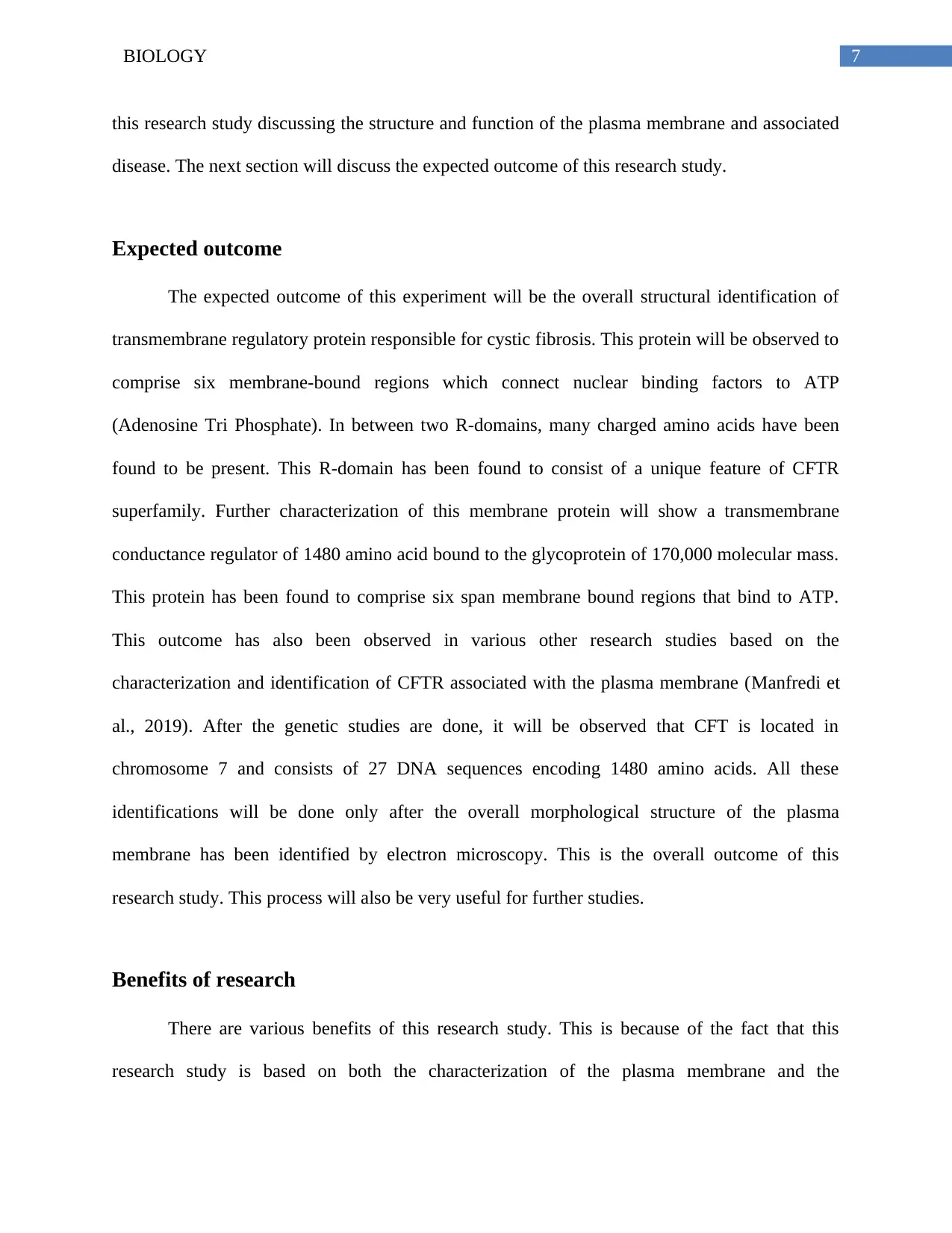
7BIOLOGY
this research study discussing the structure and function of the plasma membrane and associated
disease. The next section will discuss the expected outcome of this research study.
Expected outcome
The expected outcome of this experiment will be the overall structural identification of
transmembrane regulatory protein responsible for cystic fibrosis. This protein will be observed to
comprise six membrane-bound regions which connect nuclear binding factors to ATP
(Adenosine Tri Phosphate). In between two R-domains, many charged amino acids have been
found to be present. This R-domain has been found to consist of a unique feature of CFTR
superfamily. Further characterization of this membrane protein will show a transmembrane
conductance regulator of 1480 amino acid bound to the glycoprotein of 170,000 molecular mass.
This protein has been found to comprise six span membrane bound regions that bind to ATP.
This outcome has also been observed in various other research studies based on the
characterization and identification of CFTR associated with the plasma membrane (Manfredi et
al., 2019). After the genetic studies are done, it will be observed that CFT is located in
chromosome 7 and consists of 27 DNA sequences encoding 1480 amino acids. All these
identifications will be done only after the overall morphological structure of the plasma
membrane has been identified by electron microscopy. This is the overall outcome of this
research study. This process will also be very useful for further studies.
Benefits of research
There are various benefits of this research study. This is because of the fact that this
research study is based on both the characterization of the plasma membrane and the
this research study discussing the structure and function of the plasma membrane and associated
disease. The next section will discuss the expected outcome of this research study.
Expected outcome
The expected outcome of this experiment will be the overall structural identification of
transmembrane regulatory protein responsible for cystic fibrosis. This protein will be observed to
comprise six membrane-bound regions which connect nuclear binding factors to ATP
(Adenosine Tri Phosphate). In between two R-domains, many charged amino acids have been
found to be present. This R-domain has been found to consist of a unique feature of CFTR
superfamily. Further characterization of this membrane protein will show a transmembrane
conductance regulator of 1480 amino acid bound to the glycoprotein of 170,000 molecular mass.
This protein has been found to comprise six span membrane bound regions that bind to ATP.
This outcome has also been observed in various other research studies based on the
characterization and identification of CFTR associated with the plasma membrane (Manfredi et
al., 2019). After the genetic studies are done, it will be observed that CFT is located in
chromosome 7 and consists of 27 DNA sequences encoding 1480 amino acids. All these
identifications will be done only after the overall morphological structure of the plasma
membrane has been identified by electron microscopy. This is the overall outcome of this
research study. This process will also be very useful for further studies.
Benefits of research
There are various benefits of this research study. This is because of the fact that this
research study is based on both the characterization of the plasma membrane and the
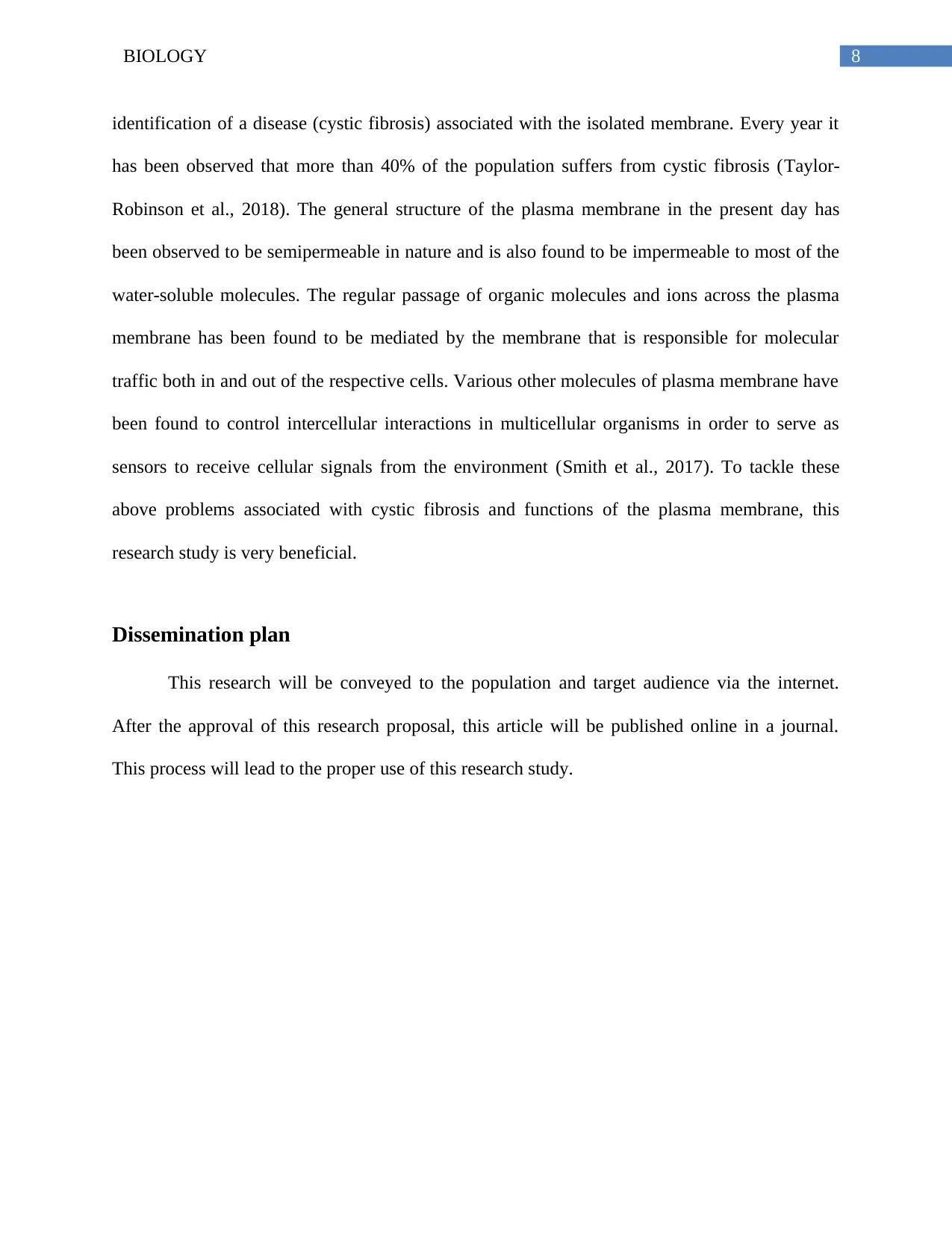
8BIOLOGY
identification of a disease (cystic fibrosis) associated with the isolated membrane. Every year it
has been observed that more than 40% of the population suffers from cystic fibrosis (Taylor-
Robinson et al., 2018). The general structure of the plasma membrane in the present day has
been observed to be semipermeable in nature and is also found to be impermeable to most of the
water-soluble molecules. The regular passage of organic molecules and ions across the plasma
membrane has been found to be mediated by the membrane that is responsible for molecular
traffic both in and out of the respective cells. Various other molecules of plasma membrane have
been found to control intercellular interactions in multicellular organisms in order to serve as
sensors to receive cellular signals from the environment (Smith et al., 2017). To tackle these
above problems associated with cystic fibrosis and functions of the plasma membrane, this
research study is very beneficial.
Dissemination plan
This research will be conveyed to the population and target audience via the internet.
After the approval of this research proposal, this article will be published online in a journal.
This process will lead to the proper use of this research study.
identification of a disease (cystic fibrosis) associated with the isolated membrane. Every year it
has been observed that more than 40% of the population suffers from cystic fibrosis (Taylor-
Robinson et al., 2018). The general structure of the plasma membrane in the present day has
been observed to be semipermeable in nature and is also found to be impermeable to most of the
water-soluble molecules. The regular passage of organic molecules and ions across the plasma
membrane has been found to be mediated by the membrane that is responsible for molecular
traffic both in and out of the respective cells. Various other molecules of plasma membrane have
been found to control intercellular interactions in multicellular organisms in order to serve as
sensors to receive cellular signals from the environment (Smith et al., 2017). To tackle these
above problems associated with cystic fibrosis and functions of the plasma membrane, this
research study is very beneficial.
Dissemination plan
This research will be conveyed to the population and target audience via the internet.
After the approval of this research proposal, this article will be published online in a journal.
This process will lead to the proper use of this research study.
⊘ This is a preview!⊘
Do you want full access?
Subscribe today to unlock all pages.

Trusted by 1+ million students worldwide
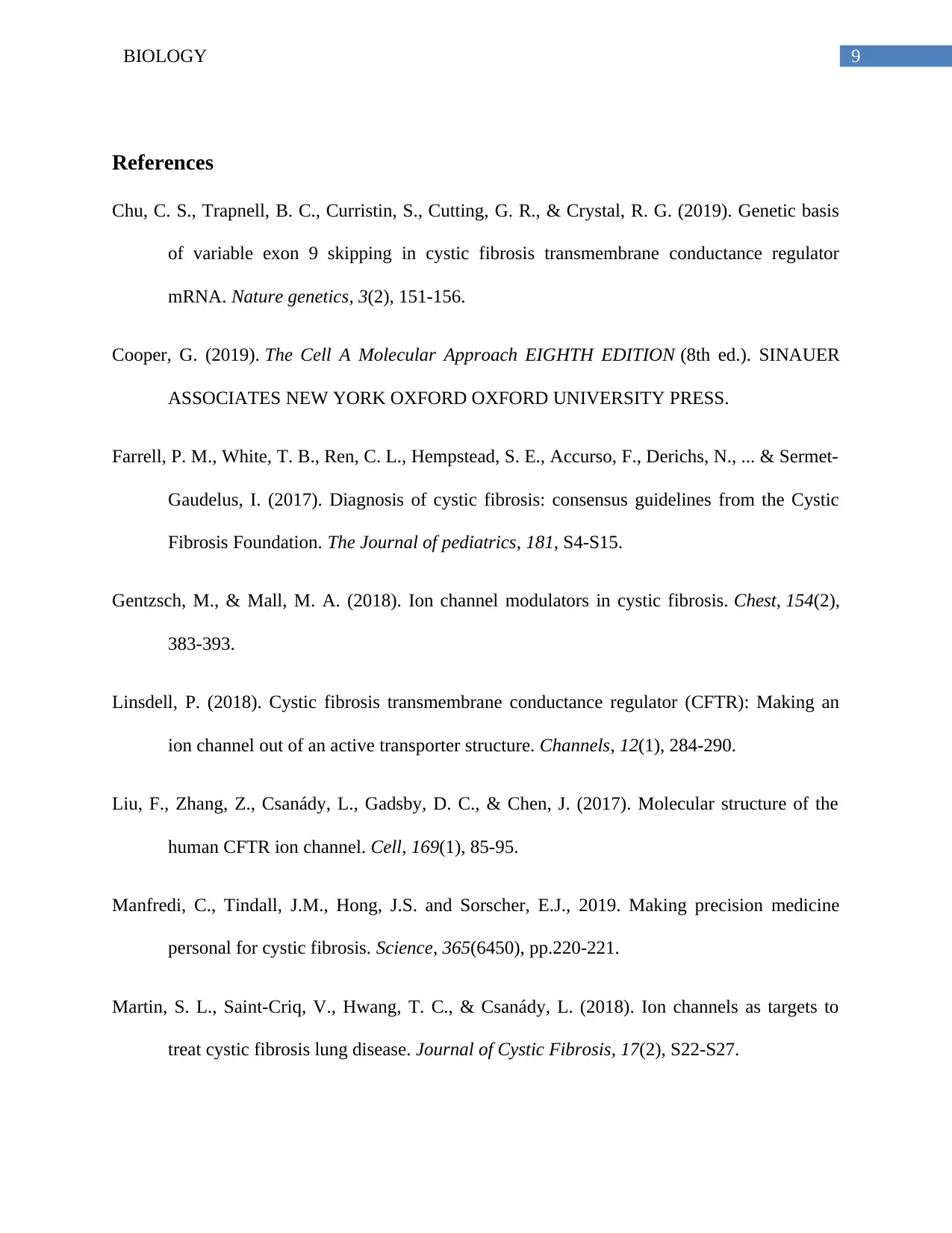
9BIOLOGY
References
Chu, C. S., Trapnell, B. C., Curristin, S., Cutting, G. R., & Crystal, R. G. (2019). Genetic basis
of variable exon 9 skipping in cystic fibrosis transmembrane conductance regulator
mRNA. Nature genetics, 3(2), 151-156.
Cooper, G. (2019). The Cell A Molecular Approach EIGHTH EDITION (8th ed.). SINAUER
ASSOCIATES NEW YORK OXFORD OXFORD UNIVERSITY PRESS.
Farrell, P. M., White, T. B., Ren, C. L., Hempstead, S. E., Accurso, F., Derichs, N., ... & Sermet-
Gaudelus, I. (2017). Diagnosis of cystic fibrosis: consensus guidelines from the Cystic
Fibrosis Foundation. The Journal of pediatrics, 181, S4-S15.
Gentzsch, M., & Mall, M. A. (2018). Ion channel modulators in cystic fibrosis. Chest, 154(2),
383-393.
Linsdell, P. (2018). Cystic fibrosis transmembrane conductance regulator (CFTR): Making an
ion channel out of an active transporter structure. Channels, 12(1), 284-290.
Liu, F., Zhang, Z., Csanády, L., Gadsby, D. C., & Chen, J. (2017). Molecular structure of the
human CFTR ion channel. Cell, 169(1), 85-95.
Manfredi, C., Tindall, J.M., Hong, J.S. and Sorscher, E.J., 2019. Making precision medicine
personal for cystic fibrosis. Science, 365(6450), pp.220-221.
Martin, S. L., Saint-Criq, V., Hwang, T. C., & Csanády, L. (2018). Ion channels as targets to
treat cystic fibrosis lung disease. Journal of Cystic Fibrosis, 17(2), S22-S27.
References
Chu, C. S., Trapnell, B. C., Curristin, S., Cutting, G. R., & Crystal, R. G. (2019). Genetic basis
of variable exon 9 skipping in cystic fibrosis transmembrane conductance regulator
mRNA. Nature genetics, 3(2), 151-156.
Cooper, G. (2019). The Cell A Molecular Approach EIGHTH EDITION (8th ed.). SINAUER
ASSOCIATES NEW YORK OXFORD OXFORD UNIVERSITY PRESS.
Farrell, P. M., White, T. B., Ren, C. L., Hempstead, S. E., Accurso, F., Derichs, N., ... & Sermet-
Gaudelus, I. (2017). Diagnosis of cystic fibrosis: consensus guidelines from the Cystic
Fibrosis Foundation. The Journal of pediatrics, 181, S4-S15.
Gentzsch, M., & Mall, M. A. (2018). Ion channel modulators in cystic fibrosis. Chest, 154(2),
383-393.
Linsdell, P. (2018). Cystic fibrosis transmembrane conductance regulator (CFTR): Making an
ion channel out of an active transporter structure. Channels, 12(1), 284-290.
Liu, F., Zhang, Z., Csanády, L., Gadsby, D. C., & Chen, J. (2017). Molecular structure of the
human CFTR ion channel. Cell, 169(1), 85-95.
Manfredi, C., Tindall, J.M., Hong, J.S. and Sorscher, E.J., 2019. Making precision medicine
personal for cystic fibrosis. Science, 365(6450), pp.220-221.
Martin, S. L., Saint-Criq, V., Hwang, T. C., & Csanády, L. (2018). Ion channels as targets to
treat cystic fibrosis lung disease. Journal of Cystic Fibrosis, 17(2), S22-S27.
Paraphrase This Document
Need a fresh take? Get an instant paraphrase of this document with our AI Paraphraser
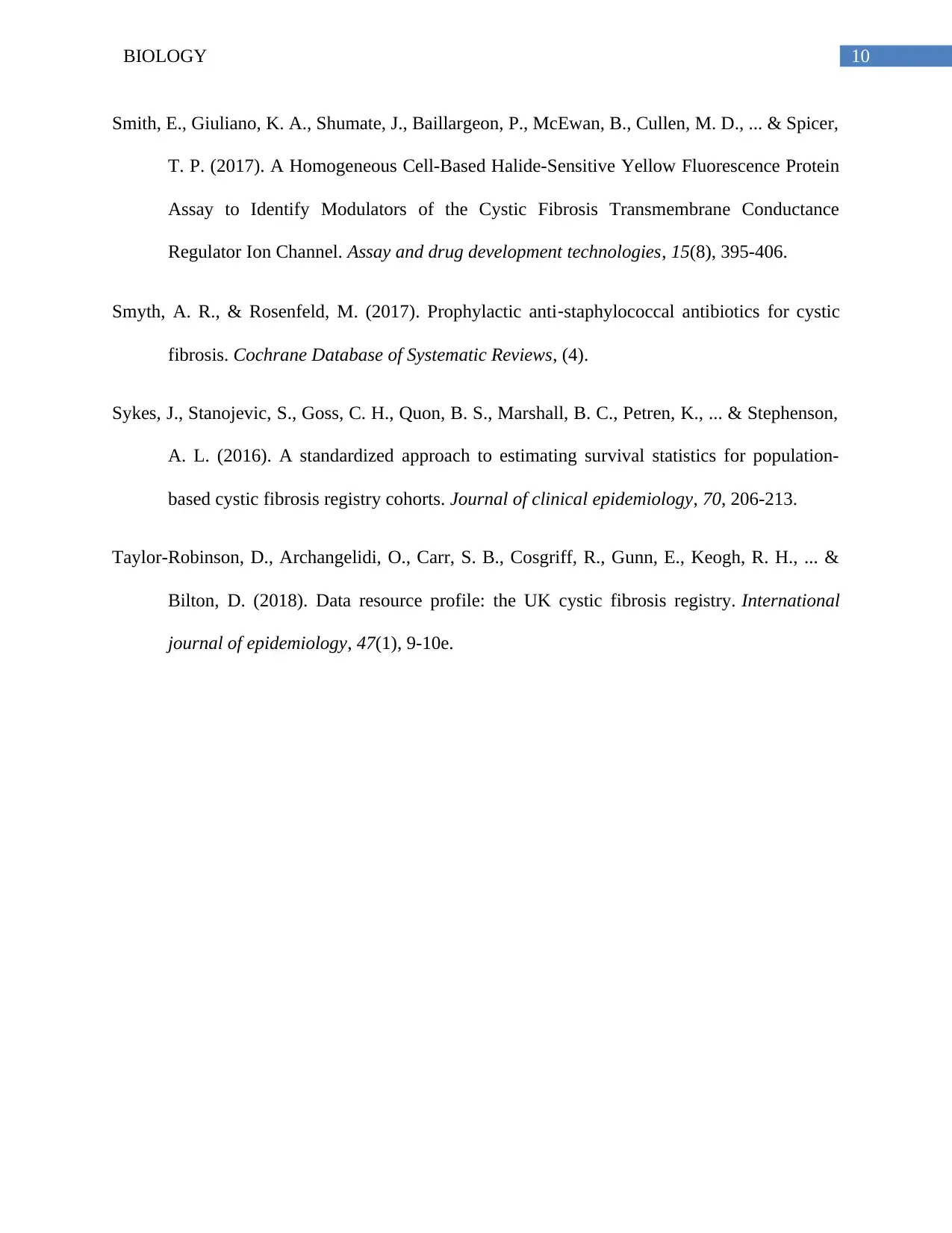
10BIOLOGY
Smith, E., Giuliano, K. A., Shumate, J., Baillargeon, P., McEwan, B., Cullen, M. D., ... & Spicer,
T. P. (2017). A Homogeneous Cell-Based Halide-Sensitive Yellow Fluorescence Protein
Assay to Identify Modulators of the Cystic Fibrosis Transmembrane Conductance
Regulator Ion Channel. Assay and drug development technologies, 15(8), 395-406.
Smyth, A. R., & Rosenfeld, M. (2017). Prophylactic anti‐staphylococcal antibiotics for cystic
fibrosis. Cochrane Database of Systematic Reviews, (4).
Sykes, J., Stanojevic, S., Goss, C. H., Quon, B. S., Marshall, B. C., Petren, K., ... & Stephenson,
A. L. (2016). A standardized approach to estimating survival statistics for population-
based cystic fibrosis registry cohorts. Journal of clinical epidemiology, 70, 206-213.
Taylor-Robinson, D., Archangelidi, O., Carr, S. B., Cosgriff, R., Gunn, E., Keogh, R. H., ... &
Bilton, D. (2018). Data resource profile: the UK cystic fibrosis registry. International
journal of epidemiology, 47(1), 9-10e.
Smith, E., Giuliano, K. A., Shumate, J., Baillargeon, P., McEwan, B., Cullen, M. D., ... & Spicer,
T. P. (2017). A Homogeneous Cell-Based Halide-Sensitive Yellow Fluorescence Protein
Assay to Identify Modulators of the Cystic Fibrosis Transmembrane Conductance
Regulator Ion Channel. Assay and drug development technologies, 15(8), 395-406.
Smyth, A. R., & Rosenfeld, M. (2017). Prophylactic anti‐staphylococcal antibiotics for cystic
fibrosis. Cochrane Database of Systematic Reviews, (4).
Sykes, J., Stanojevic, S., Goss, C. H., Quon, B. S., Marshall, B. C., Petren, K., ... & Stephenson,
A. L. (2016). A standardized approach to estimating survival statistics for population-
based cystic fibrosis registry cohorts. Journal of clinical epidemiology, 70, 206-213.
Taylor-Robinson, D., Archangelidi, O., Carr, S. B., Cosgriff, R., Gunn, E., Keogh, R. H., ... &
Bilton, D. (2018). Data resource profile: the UK cystic fibrosis registry. International
journal of epidemiology, 47(1), 9-10e.
1 out of 11
Related Documents
Your All-in-One AI-Powered Toolkit for Academic Success.
+13062052269
info@desklib.com
Available 24*7 on WhatsApp / Email
![[object Object]](/_next/static/media/star-bottom.7253800d.svg)
Unlock your academic potential
Copyright © 2020–2025 A2Z Services. All Rights Reserved. Developed and managed by ZUCOL.





